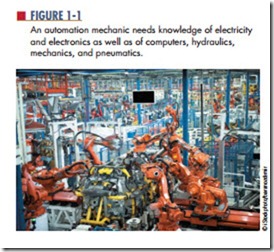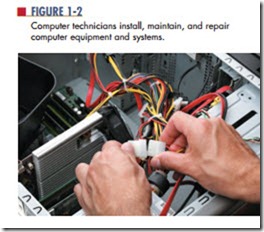This chapter looks at careers in the electrical and electronics industry. It also looks at some useful information for locating a job and developing skills to secure a job, as well as some pointers to keep a job. It is not realistic for an individual to make a career choice after reading this chapter; rather, this chapter is a starting point to help define the process of getting a job.
1–1 Careers in the electrical and electronics Field
Many exciting career opportunities exist in the electrical and electronics field. The following pages provide a sample of the available opportunities. Check for other career opportunities at the career information center in your school or community.
automation Mechanic
An automation mechanic maintains controllers, assembly equipment, copying machines, robots, and other automated or computerized devices (Figure 1-1). A person with this job installs, repairs, and services machinery with electrical, mechanical, hydraulic, or pneumatic components. Precision measuring instruments, test equipment, and hand tools are used. Knowledge of electronics and the ability to read wiring diagrams and schematics is required.
Becoming an automation mechanic requires for- mal training, which is offered by the military, two-year colleges, vocational-technical schools, and in-house
apprenticeship programs. Although most training is provided through formal classroom instruction, some may only be obtained through on-the-job training.
Automation mechanic is one of the fastest growing vocations in the industry. This rapid growth is expected to continue annually.
automotive Mechanic
There are currently more computers aboard today’s automobile than aboard our first spaceship. A typical automobile contains approximately 10 to 20 computers that operate everything from the engine and radio to the driver’s seat. As a result, automotive mechanics now need a greater knowledge of electronics.
To be able to distinguish an electronic malfunction from a mechanical malfunction, automotive mechanics must be familiar with the minimum basic principles of electronics. In addition, they must be able to test and replace electronic components.
Becoming an automotive mechanic requires formal training, which is offered by the military, junior/ community colleges, vocational-technical schools, and in-house apprenticeship programs. Although most training is provided through formal class- room instruction, some can only be obtained on the job. To reduce the amount of time invested in train- ing a prospective mechanic, more employers are now looking for people who have completed a formal automotive training program.
Employment opportunities are good for automotive mechanics who have completed an automotive training program and better when certified by the National Institute for Automotive Service Excellence (ASE). People whose training includes basic electron- ics skills have the best opportunities. Employment growth is expected to increase at a normal rate annu- ally, with a concentration in automobile dealerships, independent automotive repair shops, and specialty car-care chains. Employment in service stations will continue to decline, as fewer stations will offer repair services.
Computer engineer
The rapid growth in computers has generated a demand for people trained in designing new hardware and software systems and incorporating new technologies into existing and new systems. These trained professionals are known as computer engineers and system analysts.
Computer engineers can be further broken down into hardware and software engineers. Computer hardware engineers design, develop, test, and supervise the manufacturing of computer hardware. Computer software engineers design and develop software systems for control and automation of manufacturing, busi- ness, and management processes. They also may design and develop software applications for consumer use at home or create custom software applications for clients.
There is no universally accepted preparation for a computer professional because the job often depends on the work that needs to be done. Most employers re- quire that employees have at least a bachelor’s degree. However, a passion for computers and proficiency in advanced computer skills will at times win out over a bachelor’s degree.
This field is one of the fastest-growing fields today. Technological advances are occurring so rapidly in the computer field that employers are struggling to keep up with the demand for trained professionals. As the tech- nology becomes more sophisticated and complex, more expertise and a higher level of skills will be required. Computer engineers must be willing to continue their learning process to keep up. College graduates with a bachelor’s degree in computer science, computer engineering, information science, or information systems will enjoy favorable employment opportunities.
Computer technician
A computer technician installs, maintains, and re- pairs computer equipment and systems (Figure 1-2). Initially, the computer technician is responsible for laying cables and making equipment connections.
Computer technicians install, maintain, and repair computer equipment and systems.
This person must thoroughly test the new system(s), resolving all problems before the customer uses the equipment. At regular intervals, the computer technician maintains the equipment to ensure that everything is operating efficiently. Knowledge of basic and specialized test equipment and hand tools is necessary.
Computer technicians spend much of their time working with people—listening to complaints, an- swering questions, and sometimes offering advice on both equipment system purchases and ways to keep equipment operating efficiently. Experienced computer technicians often train new technicians and sometimes have limited supervisory roles before moving into a supervisory or service managerial position.
A computer technician is required to have one or two years of training in basic electronics or electrical engineering from a junior college, college or vo-ational training center, or military institution. The computer technician must be able to keep up with all the new hardware and software.
Projections indicate that employment for computer technicians will be high. The nation’s economy is ex- panding, so the need for computer equipment will in- crease; therefore, more computer technicians will be required to install and maintain equipment. Many job openings for computer technicians may develop from the need to replace technicians who leave the labor force, transfer to other occupations or fields, move into management, or retire.
electrical engineer
electrical engineers make up the largest branch of engineering. An electrical engineer designs new products, writes performance specifications, and develops maintenance requirements. Electrical engineers also test equipment, solve operating problems within a system, and predict how much time a project will require. Then, based on the time estimate, the electrical engineer determines how much the project will cost.
The electrical engineering field is divided into two specialty groups: electrical engineering and electronics engineering. An electrical engineer works in one or more areas of power-generating equipment, power-transmitting equipment, electric motors, machinery control, and lighting and wiring installation. An electronics engineer works with electronic equipment associated with radar, computers, com- munications, and consumer goods.
The number of engineers in demand is expected to increase annually. This projected growth is attributed to an increase in demand for computers, communica- tion equipment, and military equipment. Additional jobs are being created through research and develop- ment of new types of industrial robot control systems and aviation electronics. Despite this rapid growth, a majority of openings will result from a need to replace electrical and electronics engineers who leave the labor force, transfer to other occupations or fields, move into management, or retire.
electrician
An electrician may specialize in construction, main- tenance, or both. Electricians assemble, install, and maintain heating, lighting, power, air-conditioning, and refrigeration components (Figure 1-3). The work of an electrician is active and sometimes strenuous. An electrician risks injury from electrical shock, falls, and cuts from sharp objects. To decrease the risk of these job-related hazards, an electrician is taught to use protective equipment and clothing to prevent shocks and other injuries. An electrician must adhere to the National Electrical Code® (NEC®)* specifications and procedures, as well as to the requirements of state, county, and municipal electric codes.
A large proportion of electricians are trained through apprenticeship programs. These programs are compre- hensive, and people who complete them are qualified for both maintenance and construction work. Most localities require that an electrician be licensed. To obtain the license, electricians must pass an examination that tests their knowledge of electrical theory, the National Electrical Code®, and local electrical and building codes. After electricians are licensed, it is their responsibility to keep abreast of changes in the NEC guidebook, with new materials, and with methods of installation.
Employment for electricians is expected to increase annually. As population increases and the economy grows, more electricians will be needed to maintain the electrical systems used in industry and in homes. Additionally, as both new and old homes are prepared for new technologies to make them smarter, the de- mand requires more electricians who are trained in the new technologies.
electronics technician
Electronics technicians develop, manufacture, and ser- vice electronic equipment, and they use sophisticated measuring and diagnostic equipment to test, adjust, and repair electronic equipment. This equipment in- cludes radio, radar, sonar, television, and computers, as well as industrial and medical measuring and con- trolling devices.
One of the largest areas of employment for electronics technicians is in research and development. Technicians work with engineers to set up experiments and equipment and calculate the results. They also assist engineers by making prototypes of newly developed equipment and by performing routine design work. Some electronics technicians work as sales or field representatives to give advice on installation and maintenance of complex equip- ment. Most electronics technicians work in laboratories, electronics shops, or industrial plants. Ninety percent of electronics technicians work in private industry.
Becoming an electronics technician requires formal training, which is offered by the military, junior and community colleges, vocational-technical schools, or in-house apprenticeship programs.
Employment of electronics technicians is expected to increase annually due to an increased demand for computers, communication equipment, military electronics, and electronic consumer goods. Increased product demand will provide job opportunities, and the need to replace technicians who leave the labor force, transfer to other occupations or fields, move into management, or retire will also increase.


